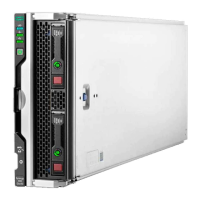System requirements for System requirements for persistent memory modulepersistent memory module support support
IMPORTANT:IMPORTANT:
Hewlett Packard Enterprise recommends that you implement best-practice configurations such as clustered
configurations for high availability (HA).
Before installing persistent memory modules, make sure that the following components and software are available:
A supported HPE ProLiant Gen10 server or Synergy compute module using second-generation Intel Xeon Scalable processors. For
more information, see the product QuickSpecs on the Hewlett Packard Enterprise website
(https://www.hpe.com/support/persistentmemoryQShttps://www.hpe.com/support/persistentmemoryQS).
HPE DDR4 Standard Memory RDIMMs or LRDIMMs (the number will vary based on your chosen configuration).
Supported firmware and drives:
System ROM version 2.10 or later
Server Platform Services (SPS) Firmware version 04.01.04.296
HPE iLO 5 Firmware version 1.43
HPE Innovation Engine Firmware version 2.1.x or later
Download the required firmware and drivers from the Hewlett Packard Enterprise website
(https://www.hpe.com/info/persistentmemoryhttps://www.hpe.com/info/persistentmemory).
A supported operating system:
Windows Server 2012 R2 with persistent memory drivers from Hewlett Packard Enterprise
Windows Server 2016 with persistent memory drivers from Hewlett Packard Enterprise
Windows Server 2019
Red Hat Enterprise Linux 7.6 and later
Red Hat Enterprise Linux 8.0 and later
SUSE Linux Enterprise Server 12 SP4 and later
SUSE Linux Enterprise Server 15 with SUSE-SU-2019:0224-1 or later kernel update
SUSE Linux Enterprise Server 15 SP1 with SUSE-SU-2019:1550-1 or later kernel update
VMware vSphere 6.7 U2 + Express Patch 10 (ESXi670-201906002) or later (supports App Direct and Memory modes)
VMware vSphere 6.5 U3 or later (supports Memory mode)
Hardware and licensing requirements for optional encryption of the persistent memory modules:
HPE TPM 2.0 (local key encryption)
HPE iLO Advanced License (remote key encryption)
Key management server (remote key encryption)
For more information, see the Intel Optane persistent memory for HPE User Guide on the Hewlett Packard Enterprise website
(https://www.hpe.com/info/persistentmemory-docshttps://www.hpe.com/info/persistentmemory-docs).

